

Why people need to leave - Refugee Council of Australia. Destination Australia. Facts About Refugees & Asylum Seekers. An immigration nation - ABC Education. Why migrants may be our greatest economic asset. Forget the myths.
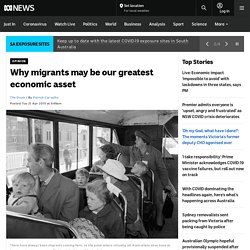
Migrants lift the three "Ps" of high economic growth - population, participation and productivity. So maybe we need to increase our intake, writes Patrick Carvalho. Ahead of the upcoming federal budget, the recent Intergenerational Report has rekindled debate about the benefits and costs of our immigration program, which is one of Australia's greatest economic assets: young, hard-working migrants with a diverse and rich cultural background that economically, politically and socially contribute to grow Australia's strength and affluence.
Unfortunately, some debaters are propagating misconceptions and myths about immigration. Even respected columnists are lured to the easy scapegoating, stating that "immigration carries a huge threat to our productivity" as a bigger Australia requires additional housing and public infrastructure. Immigration impacts Australia - National Museum of Australia. Perspectives on migrants distorted by politics of prejudice. Global migration is experiencing turbulent times.
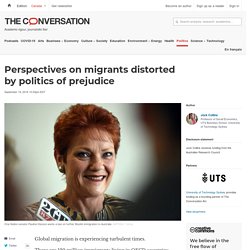
There are 120 million immigrants living in OECD countries; Australia has one of the highest immigrant populations (28.1% in 2014) of all OECD countries. Launching the International Migration Outlook 2016 at the United Nations General Assembly in New York on Monday, OECD Secretary-General Angel Gurría was worried that: Too many people in too many countries are losing faith in how we manage migration, and the refugee crisis has exacerbated this. Gurría warned about “the rising tide of anti-immigration voices” and urged OECD governments to develop more effective migration and integration policies.
Polls apart: how Australian views have changed on “boat people” - Lowy Institute. Since 2005, the annual Lowy Institute Poll has been tracking the attitudes of Australians to foreign policy issues and their place in the world.
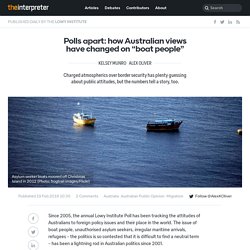
The issue of boat people, unauthorised asylum seekers, irregular maritime arrivals, refugees – the politics is so contested that it is difficult to find a neutral term – has been a lightning rod in Australian politics since 2001. The issue ofboat people,unauthorisedasylum seekers,irregularmaritime arrivals,refugees – thepolitics is socontested that itis difficult to finda neutral term. That was when then prime minister John Howard refused landing permission to a boat of more than 430 asylum seekers who had been rescued by Tampa, a Norwegian freighter, off the coast of Christmas Island. Immigration and refugees - Lowy Institute Poll 2021.
Immigration, Social Cohesion and National Identity - Parliament of Australia. Research Paper No. 1 1997-98 Professor Robert Holton, Consultant Social Policy Group 1 September 1997 Contents Major Issues Summary Immigration and multiculturalism continue to be major issues for Australians concerned about the state of the nation and its future.
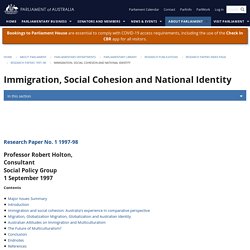
Mapping immigrants' birth places - Interactive Mapping Tool. UPDATED: Where do immigrants come from?

How culturally diverse is Australia? As proud Sydneysiders, Small Multiples loves our multicultural city. So we developed these maps to reveal the birthplaces of the biggest immigrant populations in suburbs and towns across Australia. Sydney. Australia's refugee policy: An overview. Download factsheet: Australia's Refugee Policy: An overview Australia’s key refugee policies briefly explained, including turnbacks, offshore processing, immigration detention and the situation of people in the ‘legacy caseload’.
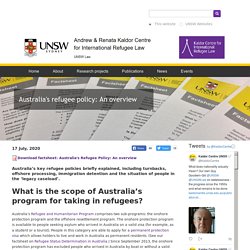
What is the scope of Australia’s program for taking in refugees? A brief history of immigration to Australia - SBS. Prime Minister Malcolm Turnbull likes to say that Australia is the most successful multicultural society in the world.

And while that might gloss over the country’s history of racial exclusion (and the three senators from anti-immigration party One Nation in federal parliament), contemporary Australia can make a good claim on the title. That’s because Australia has a higher proportion of people born overseas (26 per cent) than other high-immigration nations, including New Zealand (23 per cent), Canada (22 per cent), the United States (14 per cent), and the United Kingdom (13 per cent). In fact, the only country that has a higher overseas-born population is Saudi Arabia (32 per cent) which permits foreigners to work but does not offer permanent residency or citizenship.
Since 1945, when Australia’s immigration department was established, seven million permanent migrants have settled in Australia. Picture Post/Getty Images. Immigration Australia Timeline. Since the arrival of the First Fleet on the shores of Botany Bay in 1788, close to 10 million settlers have come from all corners of the globe to call Australia home.

Driven by the promise of a new life the Great Southern Land, waves of immigrants came to find fortune in the gold rush, to escape the social upheaval of the Industrial Revolution, two world wars and the aftermath of the Vietnam War. These migrants have played a vital role in shaping Australia’s history, forming the multicultural identity we pride ourselves on today. Timeline - Immigration Museum. Multiculturalism is embraced and then challenged.

Global rights of Indigenous peoples extend to land rights and national apologies. The Cold War ends but Western nations identify new adversaries in Muslim and Middle Eastern nations through two Gulf Wars and war in Afghanistan. Australia's migration history timeline. Aboriginal rock painting of Macassan prahu in Arnhem Land, c.2011.
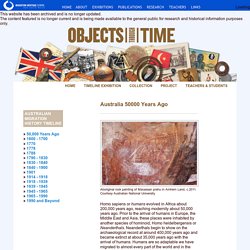
Courtesy Australian National University Homo sapiens or humans evolved in Africa about 200,000 years ago, reaching modernity about 50,000 years ago. Prior to the arrival of humans in Europe, the Middle East and Asia, these places were inhabited by another species of hominoid, Homo heidelbergensis or Neanderthals. Timeline: Australia's Immigration Policy. 1831 – 43 years after the arrival of the First Fleet and the beginning of British colonisation in Australia, the first assisted migration begins with workers from Britain encouraged to apply. Other immigrants follow that decade, including German Lutherans leaving their homeland in search of religious freedom and better economic opportunities. 1860 – Many Chinese miners take advantage of Australia's Gold Rush, but it causes tensions that come to a head in an 1860 riot. 3,000 European miners drive the Chinese off the Burrangong Goldfield in New South Wales. 1888 – Tensions continue over Chinese workers and in 1888 the Premiers of all the pre-Federation colonies (except Tasmania) agree to further restrict Chinese immigrants. 1901 – Among the first laws passed by the Federal Government in the new Commonwealth of Australia is the Immigration Restriction Act 1901.
It introduces a dictation test to prevent 'non-whites' from entering Australia as immigrants. Timeline of refugees and Australia. Australian Migration: The Italian Experience. Arriving In Australia - NFSA. Immigration Stories : Immigration Place. Throughout history stories have been used to illuminate, to educate, to recount, to challenge and to engage.
Every individual’s life experience is unique and dynamic, particularly for those of us who have journeyed far from our homes to establish new lives in foreign countries. Australia’s migrant history has enabled us to develop into the strong nation we are today. Personal stories and anecdotes are an important opportunity to enrich the public record and to embellish our history. Immigration Place Australia encourages the collection of immigrant stories. Refugee Stories and Recollections - Refugee Council of Australia. NSW Migration Heritage Centre. I believe that institutional racism is a much greater problem in Australian society than we are prepared to acknowledge, and it informs behaviours without people even realising it – even in people who think they are embracing a multicultural society. … Continue reading Author: Charles Wong, urban dweller Migrants hope for a better life, but how far short do they ever think their expectations may fall?
Since my arrival here in 1985, I have led, it seems to me, a thoroughly uneventful, middle-class … Continue reading. Sydney Quarantine Station (Our History) - Q STATION. We stand today on this land, now known as North Head. It is Car-rang gel / Garangal, saltwater country. May we always be respectful of the knowledge borne of the Aboriginal custodianship of this land and the continuing connection to the land, waters, and sky. We honour the presence of the ancestors who reside in the living memory and practice of this land and pay our respects to their Elders – past, present and emerging.
" Dr Frank Leslie Utber, Matron Wilshire, (bottom)Sister Green, Sister Gwendoline Jones, Mr Wilshire - c.1890 / Image courtesy of Mrs N.Skinner (QS2007.60) As Australia’s longest continuously operating quarantine station, our site has undergone significant change over time. Quarantine Station - MGNSW. Quarantine Station The historic Quarantine Station is located in Manly on Sydney’s North Head, an area which has important cultural and spiritual significance to the land’s traditional owners. The site is part of the rich history of Aboriginal occupation of the Sydney area. Chosen in 1832 as the ideal site for the development of a quarantine facility, due to its isolation, deep anchorage options, fresh water spring and proximity to the entrance to Sydney Harbour, the site reflects the evolving cultural landscape of colonial Australia, as well as demonstrating the impact of changing social attitudes and scientific and medical developments.
The small but comprehensive museum relays the historical, material. social, cultural, and political influences in the evolution of the site. The site’s 65 heritage buildings reflect a rich history.